



Derivativity is key notion in analysis, because it underlies all physics and science in general.
Let \( f :x \longmapsto f(x) \) be a continuous function.
We do call \( f'(a) \) the derived number from the function \( f \) at point \( (x=a )\) such as
If (and only if) this number is defined, we then say that \( f \) is derivable at point \( a\).
Determining the general expression of the derivative function \(f'\), we will define where the function \(f\) is derivable.
Function \(f'\), derivated from fucntion \( f \) is expressed as follows:
The is the limit of the rate variation when \( h \to 0 \).
It can also be found in this form:
At this point, it will be the limit of rate variation when \( x \to a \).
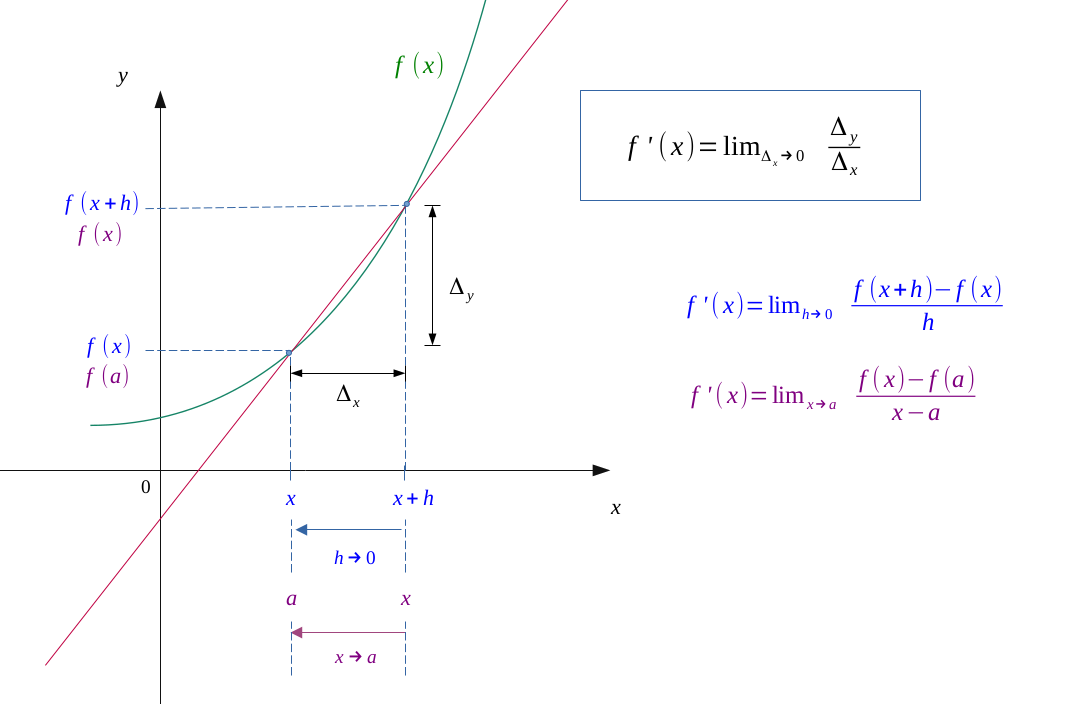
Furthermore, if and only if \(f'\) changes sign between before and after a certain point \(a\), the \(f\) function admits a local extremum at this point.

We saw in the definition of the derivative that the derived number correspond to the slope of the tangent to the curve of a function.
This line admits for equation at the point of abscissa \(a\):
Furthermore, in the case of a convex function (resp. concave), this tangent is always below (resp. above) the curve.
Let \( f :x \longmapsto f(x) \) be a function, continuous on an interval \( [a, \ a +h] \).
Let us mark two points on the abscissa axis, \( a \) and \( a +h \) (\( h \) being a relatively short distance). Their respective image being \( f(a) \) and \( f(a + h) \), we obtain two points: \( A(a; f(a)) \) and \( B(a + h; f(a + h)) \).
On the following figure, we also drawn the straight line joinin them.
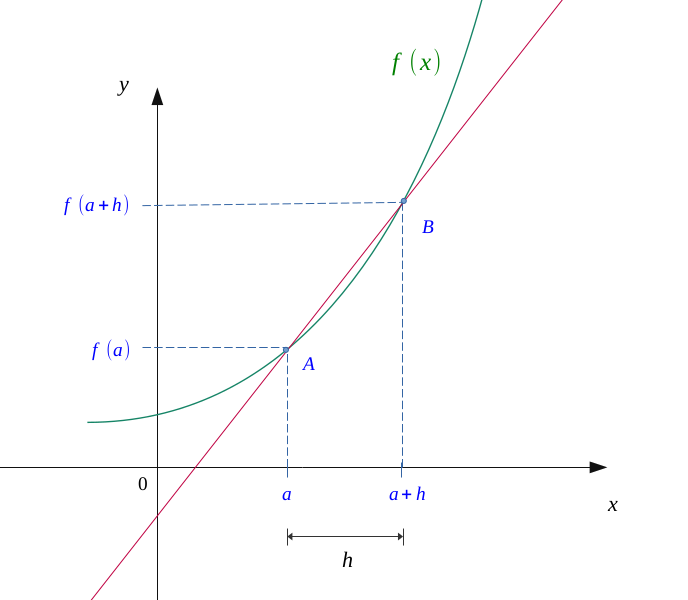
Now we can calculate a mean variation of this function between \( A \) and \( B \).
We can calculate this slope by the following formula:
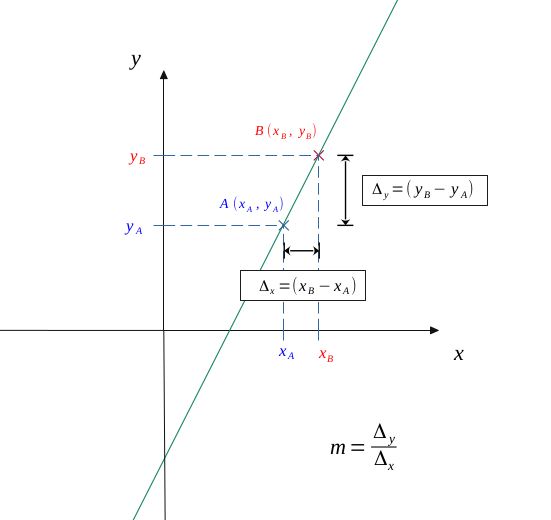
In our case, this gives:
So:
Let us gradually reduce the distance \( h \) which separates our two points on the abscissa axis, making tend \(A\) towards \(B\).
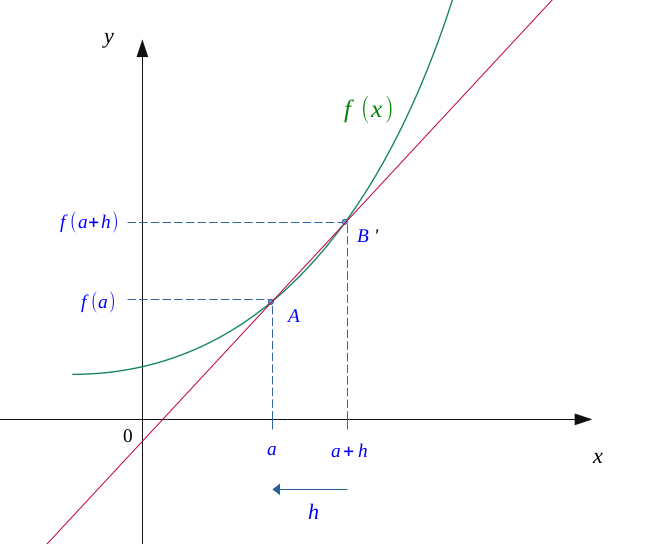
We see that the values of \( a \) and \( a + h \) started to get closer, and the line which connects \( A \) and \( B \) begin to draw a tangent to the curve.
In the same way, we will further reduce the distance \( h \), the latter begins to reduce it to \( 0 \).
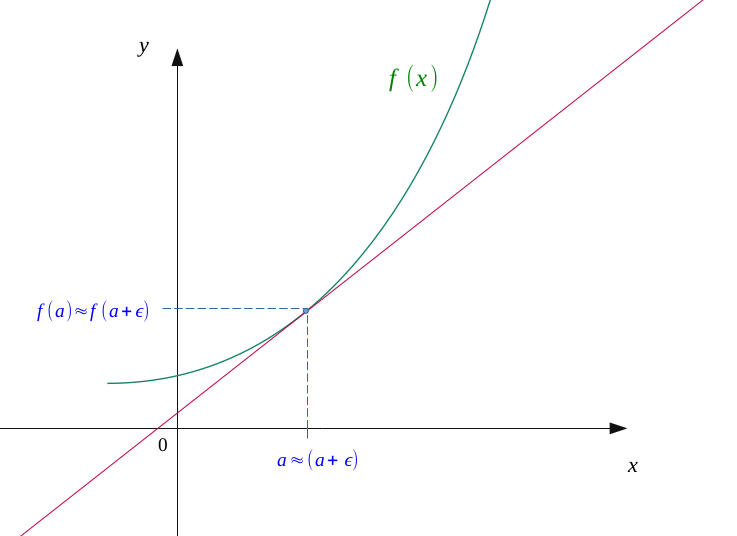
We now see that our two points \( A \) and \( B \) are almost coincident, and that we obtain an almost perfect tangent to the curve at the point of abscissa \( a \).
By imaginating that \( h \) becomes smaller and smaller approching to \( 0 \), our formula \( (1) \) can be expressed as a limit:
This number \( m\) obtained, for a \( a \) arbitrarily chosen, will be called the derived number of the function \( f \) at point \( a \). It will be noted \( f'(a) \).
If this number cannot be calculated, the derivative is not defined at this point \( a \).
Now, if (and only if) this number is defined, we will then say that \( f \) is derivable at point \( (x = a) \).
Determining the general expression of the derivative function \(f'\), we will define where the function \(f\) is derivable.
By generalizing it, that is to say for all \( x \), we call \( f' \) the derivative function of the function \( f \).
The definition set of \( f' \) will then depend of its expression, and will be restricted to the definition set of the function \( f \).
For example, the function \( ln(x) \) is only defined on \(\mathbb{R^*_+}\).
Then, its derivative function:
is also restricted (a minima) to this interval, whereas the function \( f: x \longmapsto \frac{1}{x} \) is usually defined on \(\mathbb{R^*}\), which is a larger interval.
We say that the derivative is the limit of the variation rate when \( h \) goes to \( 0 \).
We will also find it through this form:
At this stage, it will be the limit of the variation rate when \( x \to a \).

In physics, we can also use Leibniz's differential notation \( \frac{df}{dx} \), or that of Newton \( \overset{.}{f} \).
Especially for integral calculus, it is convenient to use Leibniz's.
We saw above that if a function can be derivated at point \( a\), tehen:
And as a result,
Which implies a continuity of the function \( f \) at point \( x = a\).
Let \(f\) be a positive continuous function on \(\bigl[a,b \bigr]\), and derivable on \( \hspace{0.1em} \bigl ]a,b \bigr[\).
Now let \( (x_1, x_2) \in \hspace{0.1em} \bigl ]a,b \bigr[ \), be two inner points of \( \hspace{0.1em} \bigl ]a,b \bigr[\) in this order.
According to the mean value theorem:
In our case,
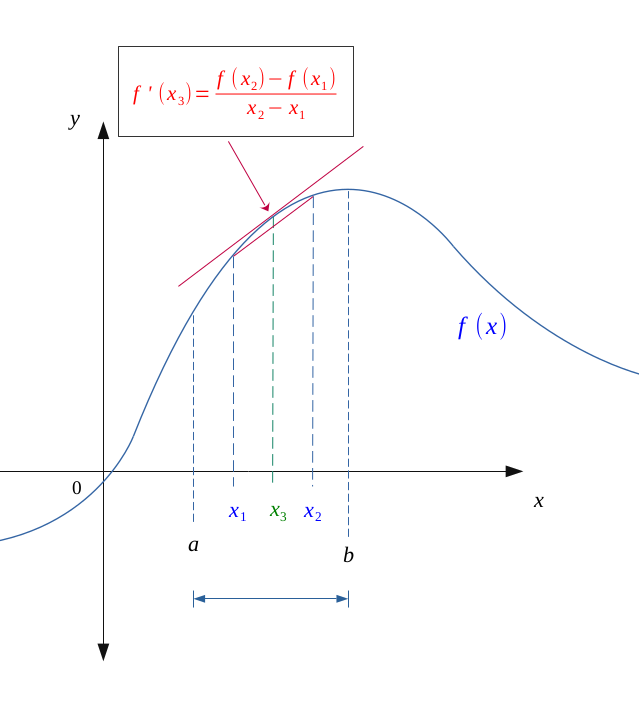
The interval \((x_2-x_1)\) being always positive, if the function \(f\) is increasing on \(\bigl[a,b \bigr]\), it is also the case on \(]x_1, x_2[\), and in this case:
The derivative function \(f'\) will be therefore positive for all \( x \in \bigl[a,b \bigr]\).
The same reasoning can be applied for a decreasing function.
Furthermore, if and only if \(f'\) changes sign between before and after a certain point \(a\), the \(f\) function admits a local extremum at this point.

This formula has to be adapted according to both cases :
Let's represent a diagram of a function and its tangent, coming from the derived number at the abscissa point \(a\).
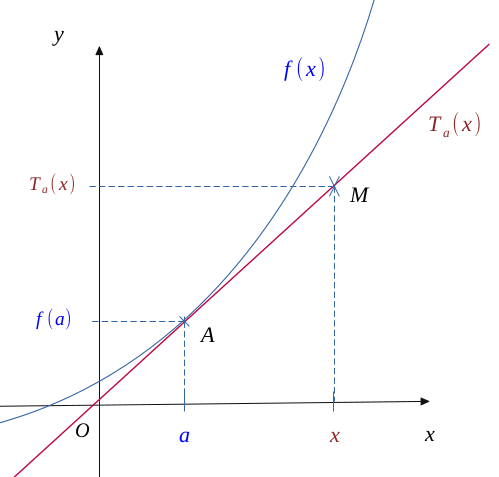
Point \(a\) then has for image \( f(a)\) or \( T_a(a)\)since by definition, a tangent is a point of intersection.
We have also placed a theoretical point \( M(x; T_a(x))\) on the tangent to the curve.
By applying the slope calculation for the points \( A \) and \( B \), we do have:
Now, we know that the slope of the tangent to the curve at the abscissa point \( a \) is the same as the derived number in \( a \):
So, by injecting \( (3) \) into \( (2) \),
And as \( T_a(a) = f(a) \),
The tangent to the curve at the abscissa point \(a\) admits for equation:
Furthermore, in the case of a convexe function, within any interval \(I = \bigl[a, b \bigr]\), any rope going on either side of these two points is above the curve.
Its tangent can then only be below:
And the inequality will be reversed in the case of a concave function.
We saw above that the equation to the curve at point \(a\) was worth :
Then, we can represent the curve of this tangent \(T_a\), with that of the study function \(f\), and notice that for any point \(M(x, y)\), there is a difference \(\varepsilon_a(x)\) between these two functions.
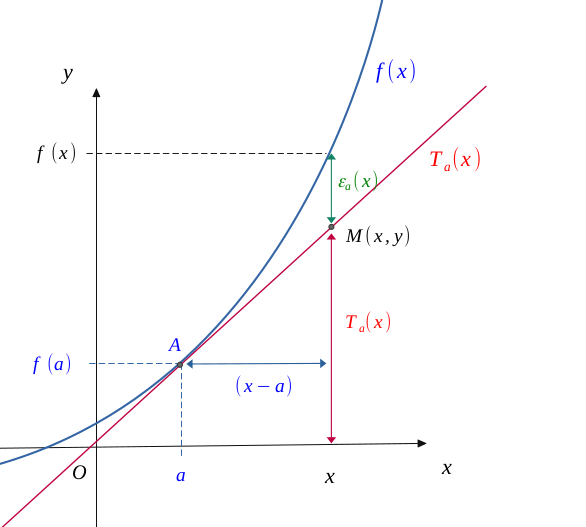
If a function \(f\) admits a Taylor series of order \(1\) at point \(a\) \((TS_n(a))\), then at the neighbourhood of \((x = a)\):
Which implies the existence of \(f'(a)\). So,
Now, if a function is derivable at point \(a\), as the previous figure clearly illustrates:
Replacing \(T_a(x)\) by its value, we do obtain:
And in the end,
And since at point \((x=a)\), we do have the equality \(f(x) = T_a (x)\), we do also have that:
Which is the definition of a Taylor series or order \(1\). Thus,
The two previous implications give rise to an equivalence, namely:
Let us study the variations of a function \(f\) such as:
This function is only defined on: \( D_f = \ ] 0, +\infty[\).
Calculating its derivative \(f'\), we do have:
\(f'(x)\) is always negative on \(D_f\).
Thus, \(f(x)\) will be decreasing on this interval.
|
$$ x $$
|
$$ 0 $$
|
$$ \dots $$
|
$$ +\infty $$
|
|---|---|---|---|
|
$$ sign \ of \ f' $$
|
$$ \bigl ]-\infty \bigr] $$
|
$$- $$
|
$$ \bigl [ 0^- \bigr] $$
|
|
$$ variations \ of \ f $$
|
$$ \bigl [+\infty\bigr] $$
|

|
$$ \bigl ]-\infty \bigr] $$
|
Furthermore:
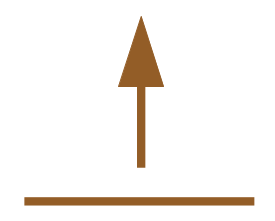 Go to the top of the page
Go to the top of the page